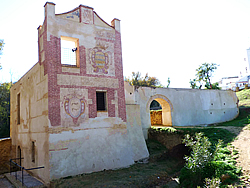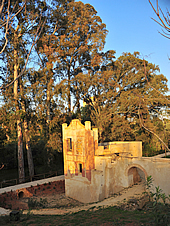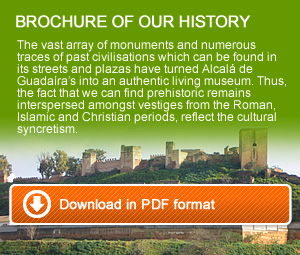


La Tapada Mill is a two-bucket mill, fed when it used to work by the water from "Del Piojo" Fountain, placed not very far away at the surroundings of the road to Utrera. Its surroundings frame a historic landscape that in spite of their contemporary alteration are perfectly registered. The mill is located on the left bank of the Guadaíra, among the Bridge of Carlos III, the Hill of the hermitage of St. Roque and Utrera's road.
Regarding its name of The Veiled Woman, it was already of common use in early 19th century, when Leandro José de Flores attributed it to a popular legend about the presence of a penitent woman at a cave of the surroundings, being this one the event taken to a novel a few years later by José María Gutiérrez de Alba. From a documentary perspective, first news related to La Tapada Mill is linked to its belonging to the Afán de Ribera family, already by the end of the 16th century. It is also known that along with other properties of a family from Alcalá, Afán de Ribera, would become a part of the resources given in 1649 to the Convent of St. John of God (San Juan de Dios in Spanish) Foundation. From this moment on, although with different lessors, the property of the mill would be kept by the congregation of Alcalá until the first third of the 19th century, when political disturbances (French invasion, Constitutional Three Years Period and the ecclesiastical confiscations) would end up with the loss of this property by the Order, and also with the definitive collapse of the mill.

Besides the mill, the documents that are still kept have frequent references to its immediate surroundings, known as "La Tapada Orchard", the "Batán Orchard" or "Don Perafán's Garden". This would include all the whole area among the bridge, the River, Utrera's road and, to the East, the boundaries (today unknown) of the orchard of the Algarrobo Mill. At least in its boundary towards the bridge and the road, we know that the orchard was walled in, something we have graphic and documents evidence of. About its produce, by 1779 oranges, lemons and vegetables were grown, although during the 19th there started to be less, being at present completely lost.

The building has rectangular floor-plan, with two floors and terrace roof; although in the 19th century this became a "sobrao" or attic, by means of its covering with a gabled roof that we can see in some historic photos.
The higher plant (safe from floods) would be used like store and house, whereas in the ground floor the two millstones were placed. Water was driven to the buckets through an aqueduct; the end of this aqueduct can still be seen.
Between the 2005 and 2008 La Tapada Mill has undergone a deep restoration that has given it back its constructive integrity. The two floors and the passable terrace roof have been recovered, as well as -partially- the area surrounding the mill of the former orchard. The subsisting stretch of the aqueduct has also been restored. But possibly the most interesting detail is the recovery of the pictorial decoration of the west façade, which includes imitation-brick polishings, heraldic and Marian emblems and a sign with epigraphy, all of them symbols of the nobility and ecclesiastic property of the mill along the entire Modern Age.

